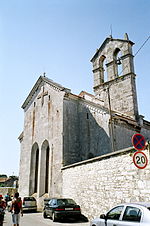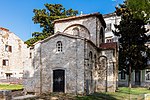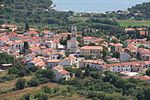Pula Cathedral

The Pula Cathedral or fully the Cathedral of the Assumption of the Blessed Virgin Mary (Croatian: Katedrala uznesenja Blažene Djevice Marije) is a co-cathedral in Pula, Croatia. Along with the Euphrasian Basilica it is one of the two official seats of the Roman Catholic Diocese of Poreč and Pula. The church is located on the south side of the Pula bay at the foot of the hill with the 17th century Venetian fort. The site of the present-day church has been used for religious worship since ancient Roman times and the first Christian churches on the site were built in the late 4th and early 5th century AD. These had gone through a series of enlargements and reconstructions over the ages.
Excerpt from the Wikipedia article Pula Cathedral (License: CC BY-SA 3.0, Authors, Images).Pula Cathedral
Kandlerova ulica, Grad Pula Monte Zaro (Pula)
Geographical coordinates (GPS) Address External links Nearby Places Show on map
Geographical coordinates (GPS)
| Latitude | Longitude |
|---|---|
| N 44.871666666667 ° | E 13.844444444444 ° |
Address
katedrala Uznesenja Blažene Djevice Marije
Kandlerova ulica
52103 Grad Pula, Monte Zaro (Pula)
Croatia
Open on Google Maps










